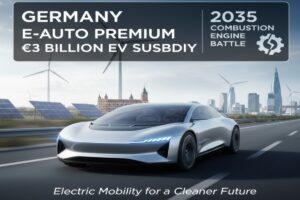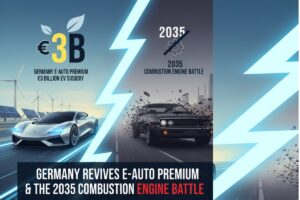Germany’s Electric Car Subsidy Makes a Comeback: A Multi-Billion Euro Lifeline for the Auto Industry
In a decisive move to counter a deepening crisis in its flagship automotive sector, Germany’s coalition government has announced the return of its electric vehicle (EV) purchase subsidy. The new program targets low and middle-income households and aims to revive demand while the political debate over the combustion engine continues.Germany Revives E-Auto Premium: New €3 Billion EV Subsidy & The 2035 Combustion Engine Battle
The Driving Force Behind the New Subsidy: An Industry in Crisis
The announcement from the Chancellery follows urgent crisis meetings in October 2025. It was prompted by alarming signals from the German auto industry: after the previous subsidy (the Umweltprämie) expired in late 2023, electric car sales cooled sharply. Ambitious targets—such as 15 million electric cars on German roads by 2030—now look increasingly out of reach. With only around 1.7 million fully battery-electric vehicles registered, the gap is substantial.
Beyond falling sales, the industry faces an employment crisis. The transition to electromobility requires fewer workers than the production of combustion-engine vehicles, and a large part of battery value creation occurs outside Germany. Consultancy firm reports indicated that approximately 50,000 jobs were lost in the German auto industry within a single year, increasing pressure on policymakers and unions to act. The “Autogipfel” (Auto Summit) was convened to tackle this confluence of falling demand and rising unemployment.
Breaking Down the New E-Auto Funding Plan: Key Details

The coalition committee and the Auto-Dialog produced a concrete funding package designed to be more targeted and sustained than prior measures. Key aspects of the plan are summarized below.
| Aspect | Details |
|---|---|
| Total National Funding | €3 Billion |
| Program Duration | Until 2029 |
| Annual Allocation | €750 Million per year from the national Climate and Transformation Fund (KTF) |
| Co-Financing Source | Additional funds from the EU’s Climate Social Fund |
| Primary Target Group | Low and middle-income households |
| Additional Funding | €3 Billion for road construction, reallocated from other budgets |
| Main Objective | To create “tangible benefits for consumers” and ease the switch to zero-emission vehicles |
The funding design is notable: national KTF contributions are structured to unlock larger EU funds—making the domestic commitment essential to accessing the broader European financing available to maximize consumer support.
A Tale of Two Debates: Subsidies Secured, Combustion Engine Ban in Limbo
While the coalition agreed on the subsidy, it remains deeply divided over the EU’s 2035 ban on the sale of new combustion-engine cars. The EU law currently requires that, from 2035, new registered vehicles must be zero tailpipe CO₂ emitters—effectively favoring battery electric vehicles (BEVs).
Within Germany, political voices have taken differing positions:
- Chancellor Friedrich Merz (CDU): Advocates lobbying in Brussels for “more flexibility,” seeking protection for plug-in hybrids and range-extender technologies beyond 2035.
- CSU Leader Markus Söder: Strongly opposes the strict 2035 phase-out, calling it the “wrong path” and stressing the need to safeguard German industry.
- SPD: Divided. Environment Minister Carsten Schneider defends the 2035 ban, while Vice-Chancellor Lars Klingbeil has shown openness to technological flexibility.
Industry groups and unions echoed calls for flexibility. VDA President Hildegard Müller urged Germany to speak with one voice in Brussels; IG Metall leader Christiane Benner demanded clear signals for workers, calling for a dual strategy: aggressive support for e-mobility alongside room for hybrids and climate-neutral fuels.
The Technological wildcard: E-Fuels and Lifecycle Emissions

The government is pushing alternative technologies into the debate. The CDU/CSU are betting on synthetic fuels (e-fuels) and biofuels—produced with renewable energy and presented as a path to carbon-neutral combustion. Berlin’s tactical aim is to broaden EU assessment from tailpipe emissions to a well-to-wheel or full lifecycle CO₂ balance, which would consider production, materials (like green steel), and battery manufacturing emissions.
Germany expects support from other automotive-heavy EU states—but faces the European Parliament, where Green and environmentalist factions are likely to resist any dilution of the 2035 mandate.
The Stark Reality Check: Germany’s Uphill Battle for E-Mobility
Even with fresh subsidies, several obstacles remain:
- Infrastructure gap: Public charging expansion, especially fast-charging, is lagging targets—creating range anxiety for buyers without reliable home charging.
- Economic headwinds: Inflation and economic uncertainty make consumers cautious about big purchases despite subsidies.
- Global competition: Chinese and other international manufacturers are producing affordable, feature-rich EVs, pressuring German brands to innovate and cut costs quickly.
Looking Ahead: Implications for Consumers and the Market
For German car buyers, the subsidy is welcome: it lowers the cost barrier and offers multi-year certainty through 2029—particularly helpful for low and middle-income households. But the unclear long-term stance on the 2035 combustion-engine ban leaves consumers facing a difficult choice: invest in a plug-in hybrid that may or may not be viable after 2035, or choose a pure battery-electric vehicle for the safer regulatory bet.
“The return of subsidies is a bold and necessary step—but it does not resolve deeper political and structural conflicts that will shape the future of Germany’s auto industry.”
Conclusion: A Bold Step Forward Amid Unresolved Conflict
Germany’s decision to reintroduce a multi-billion euro EV subsidy is a significant effort to revive a struggling industry and accelerate the switch to sustainable transport. Targeting support to lower and middle-income households refines earlier approaches. Yet the internal government split over the 2035 combustion-engine ban highlights a central tension between strict climate targets and preserving industrial competitiveness.
The coming months will test Germany’s capacity to build a coherent Brussels strategy and balance the twin goals of decarbonisation and industrial resilience. The fight over the future of the combustion engine continues—and with it, the future of a sector that has long been the backbone of Germany’s economy.

Md Imran Rahimi is the founder and main author of TechScopeHub.in. He is passionate about technology, gadgets, and automobiles, and loves to share simple yet valuable insights with readers. With a focus on honest reviews and clear comparisons, Imran’s goal is to make technology easy and useful for everyone.”
Md Imran Rahimi, TechScopeHub.in के संस्थापक और मुख्य लेखक हैं। उन्हें टेक्नोलॉजी, गैजेट्स और ऑटोमोबाइल्स का गहरा शौक है और वे अपनी सरल लेकिन उपयोगी जानकारी पाठकों के साथ साझा करना पसंद करते हैं। ईमानदार रिव्यू और स्पष्ट तुलना पर ध्यान देते हुए, इमरान का उद्देश्य है कि हर किसी के लिए टेक्नोलॉजी आसान और उपयोगी बने।”

